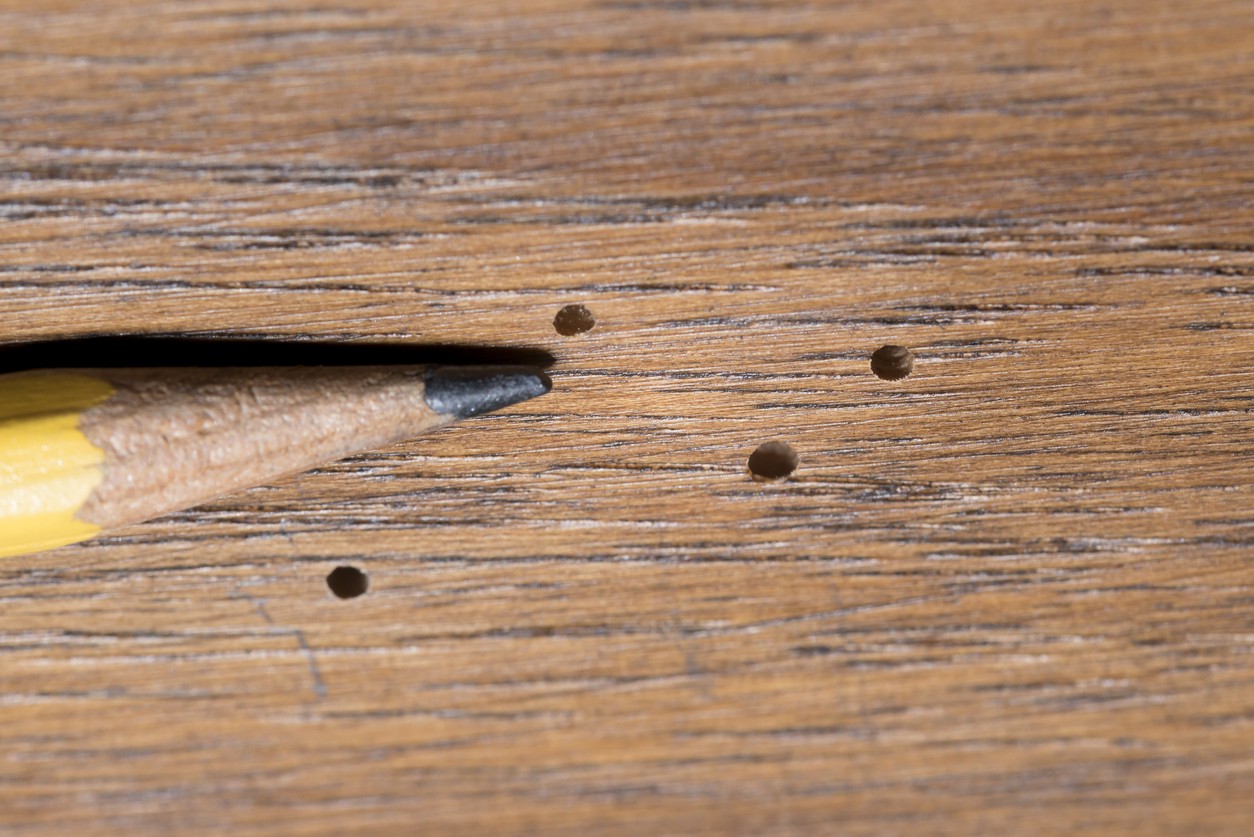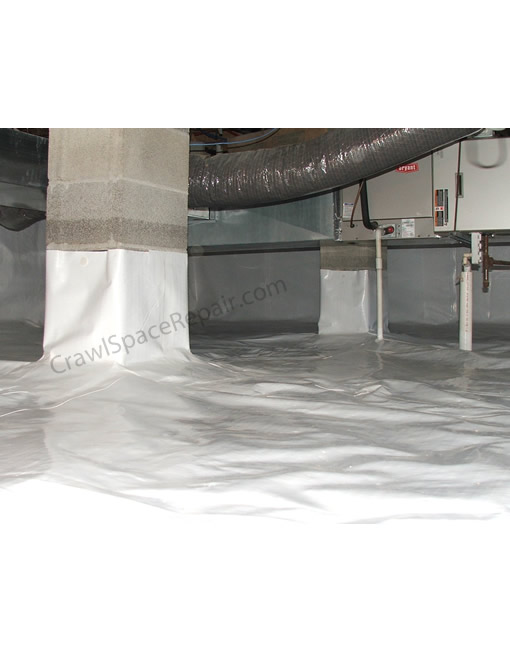Encapsulation and the impact on your home.

The negitive impact an open crawl space has on a home extends from comfort to energy waste. The research is in, the impact of indoor air pollution, costly structure repairs and the strain on the heating and cooling system caused by the crawl space environment has more home owners looking to enclose their crawl space as an all in one solution. Let us explore how is this done and how much should it cost.
The open crawl space environment
The crawl space environment is naturally harsh and unfriendly to the home above it. Generally the floor is lower in the crawl space than the outside yard causing water to settle and allowing the moisture levels to rise beyond ideal. This standing water attracts mice, termites and snakes looking for a meal into the space. Termite damage in the US is estimated at 600,000 homes and $5 Billion. If that is not bad enough the high moisture levels allow mold, mildew and fungus to germinate on the homes wood structure. A rousing case of dry rot can single handedly steal the funds set aside for your next vacation. Often, there are utilities in the crawl space like water lines, heat and cooling ducts, air handlers, water heaters and well pump tanks. In the winter the open crawl space brings dryer air but also bitter cold air threatening to burst water lines, flooding the crawl space and clobbering your wallet. Gosh, does it end there? NO. The energy expense of a home on an open crawl space is far more costly than one that is conditioned. And, the discomfort of a drafty home in the winter and stuffy home in the summer make relaxing in the home difficult. Encapsulation the crawl space relieves the home from all of these problems.
Enclosing the Crawl Space
The crawl space is part of the home even if we don't want it to be. Those vents in the foundation bring in the outside air more often than they remove the crawl space air. So, it only make sense to keep the outside out from the inside of the home. There is the right way to do this and there are many, many ways to do it the wrong. Let's start with what not to do.
Don'ts
Have you ever searched the internet for a solution to why your computer is acting up and you find an article describing exactly your problem? As you read on, their solution is to delete some folder named System32? Advice like that happens in our industry too. There is so many articles written by folks that are trying to get rankings and put out content, but do not understand what they are writing about. This leads to a lot of bad misinformation on the Internet. Sometimes, it is a company just trying to be different but not really knowing how bad their advice is. And sometimes it is some guy trying to be a kung fu celebrity YouTube star. So let's go through the basic concept steps to give you a foundation for your research.
Do's
Assess the scope of work
Most crawl spaces will need the same basic improvements. The inspection should include someone actually going inside the crawl space and traveling to all four corners, visit all support piers, all foundation vents, any appliances/equipment while inspecting the floor and rim joists along the way. Take notes either by writing it down or by voice on your phone. Take lots of pictures unless you would like to visit your dungeon a few more times. This visit is also a great time to take measurements. Usually a standard tape measure will not be long enough so a digital measuring device is recommended.
Step 1 Signs of Water

Look for water marks on the wall and effervescent in the corners. If you find wet corners this is a sign of a water problem both inside the crawl and outside home. Down spouts are located at the corners of the home and generally speaking are most likely the cause of this kind of moisture in a block wall. Keep the downspouts draining a minimum of 5' from the home on a positive grade. It is highly recommended the home have a quality sump pump system and drain pipe installed if there is any sign of water at all. Saving money on not installing a sump pump system will only ensure the following steps will be in vein. Remember water is a VERY important, 10 out of 10, problem to your home and must be solved completely or this will be your new part time wildly expensive hobby.
Step 2 Signs of Mold, Mildew and Fungus
Mold, mildew and fungus are not problems we want to have and if you do or are told you do, please get a second or even a third opinion from an expert not a salesmen. Salespeople sell and experts identify, assess and plan. It is unfortunate that everyone can not be trusted at face value, this is the reason a reputable expert with a great reputation is motivated to maintain that great reputation. This can be an expensive step or maybe not so bad with the correct assessment.
Step 3 Bugs
 Termite tunnel on a foundation wall
Termite tunnel on a foundation wall
 Powder Post Beetle
Powder Post Beetle
If you find spiders and a few rolly pollies then this is normal and harmless. If you find a termite tunnel (pic to left) on your foundation or a bunch of really small pin holes made by the Powder Post Beetle(pic to right) in your floor joists then you have a problem and it's time to call a professional to treat them. Of course then you will need to repair the damage.
Hopefully you catch it before there is any real damage. Once you encapsulate the crawl space and install a dehumidifier your chances of dealing with these pests again are greatly reduced.
Encapsulate your crawl space
Protect from future standing water
The place to save money is not on the water control system or also known as a sump pump system. It will cost you much more If you wait to do it later or think you don't need it and you are wrong. The vapor barrier will need to be removed on the perimeter far enough you can dig the drain pipe in. This means you need enough room to spread and level out the dirt you dig from the trench and sump pump hole. That is a lot of dirt, trust me. You will be muddy and crawling on and around your white barrier while you install the system. Then you will have to re-tape the walls and floors together.
If there is any signs at all of water in the crawl space, install a sump pump system. Use the dirt you take out of the trench and sump basin hole to fill the low areas of your crawl space and get it as level as you can. The finished product will look really nice if you do this.
Install a vapor barrier like GuardianLiner®

Selecting a vapor barrier is a really important step. This is also not a place to save money if you want a long lasting solution. Shop around for the best encapsulation products, ask about a written warranty and get samples. If they don't offer free samples, skip them as an option because they don't offer anything you would want to buy when compared to appropriate vapor barrier. If you want cheap plastic go to the hardware store for less money than you can buy the same thing from kung fu crawl space. If you want an engineered vapor barrier designed and tested for the crawl space then look at GuardianLiner® or SilverBack®. The encapsulation installation steps can be found here
Once your crawl space is ready to be encapsulated make sure you close the foundation vents permanently. There are so many gimmick products out there to avoid, like friction fit foundation vent covers. Super easy to install and equally easy for a mouse to remove. Do this part right. You may have heard of the term "crawl space encapsulation DIY," this simply refers to doing the encapsulation yourself versus hiring a crawl space contractor.
We also get a lot of questions about the cost of encapsulating a crawl space. This depends on a lot of different factors, but especially on the size of your crawl space. Generally speaking smaller companies will charge less to do the same work as a larger company that charges more. Workmanship is the key to the success of enclosing your crawl space. You will get a better result with great workmanship and cheap products than you will with great products and poor workmanship. The ideal situation is to get great workmanship and great products and that takes knowing how it should be done before you do it or hire someone to do it. You should also know that the cost of encapsulating your crawl space is somewhere in the neighborhood of cleaning up a bad mold problem or repairing the structure after a termite infestation. If either of these things happen to your home and god forbid they both happen you will need to encapsulate after the work to make sure it does not happen again. Or you could get ahead of the curve and spend the money to have your home protected and prevent any of that from happening.
Improvement Over A “Closed” Crawl Space
An encapsulated crawl space uses all of the features applied to a closed crawl space with a few exceptions.
To be an encapsulated crawl space the vapor barrier is continued up the foundation wall and sealed with vapor barrier tape to the floor vapor barrier. All supports, as well as plumbing that comes through the dirt and walls are also sealed. A polyurethane caulk or two sided foundation tape (like the Foundation Seal Tape™) is applied between the foundation wall and the crawl space vapor barrier to seal the moisture under the barrier. In most cases the vapor barrier that is used is made of high quality polyethylene with a polyester mesh reinforcement. Although some companies offer a clear visqueen plastic purchased from a local hardware as a solution to keep their costs down.
Controlling The Crawl Space Environment
Install a Crawl Space Dehumidifier
The purpose of crawl space encapsulation is to create an environment that can be controlled. The reason the open crawl space is so bad is because the environment is allowed to change daily, sometimes hourly. Much like building a swimming pool and refusing to full it with water because of the extra expense and time, the steps to encapsulating a crawl space should end with an environment that you are controlling with a dehumidifier. Once you have transformed the space, by way of crawl space encapsulation, into an area that is part of the house it will be cleaner and healthier for your home and family.
Encapsulation Is Needed
Maybe you have heard or read somewhere on this site that a crawl space is like a basement in many ways. Well, it is. In the function of the homes air quality and moisture penetration.
Crawl space encapsulation is essentially the same answer to a crawl space as the concrete floor in a basement. Under that concrete floor is a vapor barrier to control moisture. The concrete on the floor is for walking or use durability only. When a quality vapor barrier is used to encapsulate a crawl space it will hold up to crawl traffic and not tear like thin plastic will.
It’s "NOT" Just Plastic
Not all crawl space vapor barriers are created equal, but the truth is all will help in some way. A quality vapor barrier like the SilverBack™ brand will last for 30 years or more, while a 6 or 10 mil clear plastic from the hardware store might last 3 to 5 years. The real investment is in the time and effort it takes to do it right, so for a little bit more money up front your efforts will have a lasting result. If odor is a concern make sure the vapor barrier that is installed is made of polyethylene and not PVC. PVC liners will off gas and smell like a pool liner. If a PVC liner off gasses in the crawl space you will smell it in your home.
Radon Gas
Radon gas is a concern for all homes and all foundation types. It is a smart move to test for Radon (we offer free radon test kits with every SilverBack™ order) before having any crawl space vapor barrier installed. The SilverBack™ vapor barrier stops 98.6% of radon gas migration, but if there is a Radon gas problem there are other steps that need to be taken in order to protect your family.
If you do not properly test and investigate the proper ways to mitigate Radon gas you could make the problem much worse. A Radon gas problem is very serious and very possibly life threatening. Click here to see a US map of Radon gas concentrations
Conclusion
With an encapsulated crawl space your home and family enjoys a better indoor air quality, lower energy bills, a comfortable home and peace of mind that your home is not slowly degrading under your feet. Your home, with a healthy crawl space, will be easier to sell and will regain its full value on the home market. You might as well enjoy these benefits while you own it are living there.